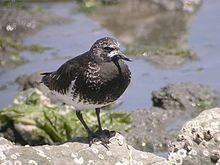Turnstone (genus)
| Turnstone | ||||||||||
|---|---|---|---|---|---|---|---|---|---|---|

|
||||||||||
| Systematics | ||||||||||
|
||||||||||
| Scientific name | ||||||||||
| Arenaria | ||||||||||
| Brisson , 1780 |

The turnstone ( Arenaria ) are a genus within the family of snipe birds . With the turnstone and the Schwarzkopf turnstone, the genus comprises only two recent species, one of which is circumpolar and the second is limited to the Nearctic . Several subspecies are distinguished for the turnstone, while the Schwarzkopf turnstone is monotypical .
Appearance
The in Central Europe occurring Turnstone reaches a body length from 22 to 24 centimeters. The wingspan reaches 45 to 56 centimeters and the weight is in the range of 80 to 190 grams. The Schwarzkopf Turnstone is almost the same size and reaches a body length of 22 to 25 centimeters. The wingspan is 50 to 55 centimeters. The weight varies between 100 and 140 grams.
The legs of both species are unusually short for a plover species in relation to the body size. The overall shape appears compact. In the splendid dress , the male turnstone has a bright maroon and black pattern on the upper side of the body. The head and the underside of the body are white with black dashes on the top and black, irregular markings on the cheeks, sides of the neck and on the chest. The female is overall somewhat dull in color and has a cream-colored spot on the neck. The breast drawing is less bright in the female. The Schwarzkopf Turnstone is less colorful than the Turnstone. In a splendid dress, he has a black head with very fine dashes on the top of the head and the neck. The white spot on the base of the beak is particularly noticeable. The beak is black, the iris is dark brown. The throat and chest are black, but individual feathers are lined with white so that they appear thickly spotted with white. The underside of the body is white, only the upper flanks are colored similar to the breast. The back, the torso and the upper tail-coverts are white, the tail is black.
In the plain dress , the Schwarzkopf turnstone is colored similar to the splendid dress, but the fine white spots are significantly reduced and above all the white spot on the base of the beak is missing. In the turnstone, the strong red-brown and black colors are missing in the magnificent dress. The head, the upper side of the body and the chest are then gray-brown with a much less pronounced blackish speckle.
distribution
The distribution area of the Turnstone extends in the north over Eurasia to the Arctic North America and Greenland. Sometimes it breeds in the High Arctic up to the 83rd north latitude (Greenland) and 80th north latitude on Spitzbergen. The Schwarzkopf Turnstone is only found in western and southern Alaska. He prefers rockier coasts than the turnstone as a habitat.
Both types are long-distance migrants. The Schwarzkopf Turnstone can be found on the west coast of the United States and Lower California during the winter months . The wintering quarters of the Turnstone are on the coasts of Western Europe, on the coasts of the Baltic States as well as in the east of the Mediterranean, in Western Asia and on the coasts of the Indian Ocean as far as South Africa. The important wintering areas of the Turnstone include the Wadden Sea of the North Sea, the Rhine-Maas Delta , the Belgian coast, the Bay of Goulven in northwest Brittany , the Île de Ré , the coast of the Isle of Thanet , the east of Sanday who have favourited Morecambe Bay and Morlaix Bay .
Way of life
The two species differ slightly in their diet. Both eat invertebrates, but mussels and crustaceans play a bigger role in the turnstone. The Schwarzkopf Turnstone also occasionally eats the eggs of smaller birds.
In both species, the nest is a shallow hollow that is covered with some plant material. The clutch comprises two to four eggs. The breeding season of 20 to 22 days for the Schwarzkopf turnstone is slightly shorter than that of the turnstone. Both parent birds are involved in the breeding of both species. The young birds of the turnstone are already fledged at 19 to 21 days, the young birds of the Schwarzkopf stone runner only at 25 to 30 days.
supporting documents
literature
- Hans-Günther Bauer, Einhard Bezzel and Wolfgang Fiedler (eds.): The compendium of birds in Central Europe: Everything about biology, endangerment and protection. Volume 1: Nonpasseriformes - non-sparrow birds. Aula-Verlag Wiebelsheim, Wiesbaden 2005, ISBN 3-89104-647-2 .
- Peter Colston , Philip Burton: Limicolen - All European wader species, identifiers, flight images, biology, distribution. BlV Verlagsgesellschaft, Munich 1989, ISBN 3-405-13647-4
- Simon Delany, Derek Scott, Tim Dodman, David Stroud (Eds.): An Atlas of Wader Populations in Africa and Western Eurasia. Wetlands International , Wageningen 2009, ISBN 978-90-5882-047-1
- Richard Sale: A Complete Guide to Arctic Wildlife , published by Christopher Helm, London 2006, ISBN 0-7136-7039-8